Maggie Daley Park is one of Chicago’s best and newest parks. Located downtown in the northeast corner of Grant Park, Maggie Daley Park is still sort of a hidden gem in Chicago, often being overlooked in favor of its more famous neighboring park, Millennium Park.
But Maggie Daley Park offers so much, and we actually somewhat prefer it to Millennium Park. In this post, we hope to provide a complete Guide to Maggie Daley Park. We cover everything from location, to what to do there, to a bit of history of the park.
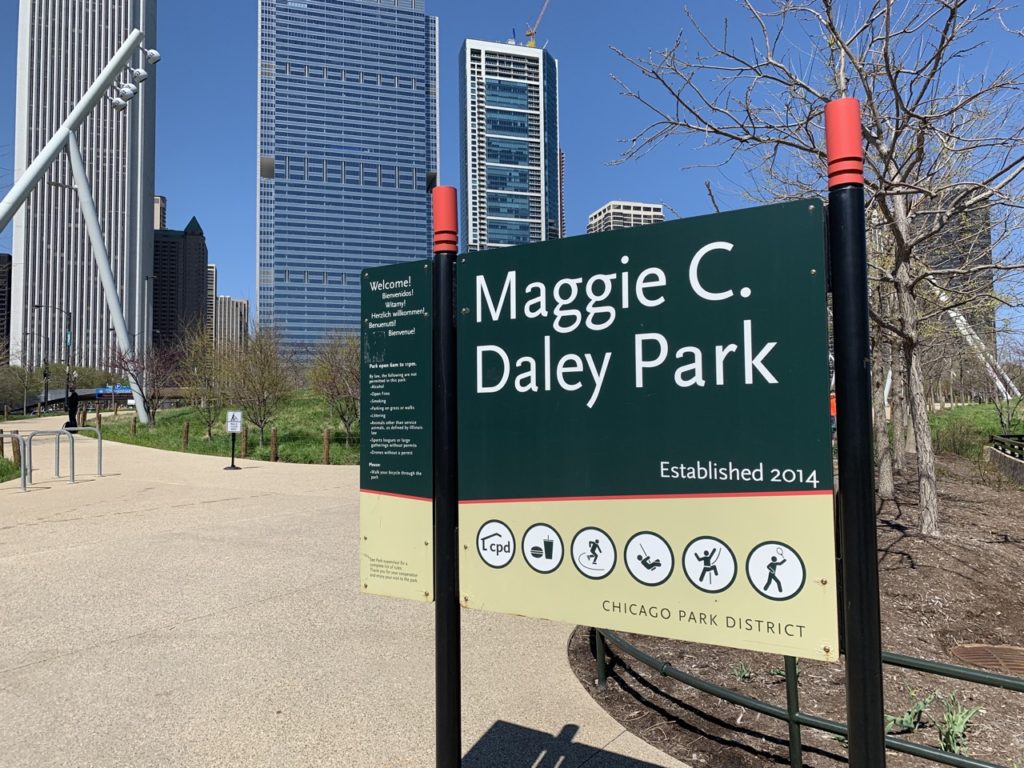
Background of Maggie Daley Park
We’re going to start with some history and a comparison to Millennium Park. If you’re just interested in planning, jump down to the next section–Maggie Daley Park Hours and When to Visit.
History of Maggie Daley Park
Maggie Daley Park was announced in 2012, a year after Maggie Daley, wife of former Chicago Mayor Richard M. Daley, passed away following a lengthy battle with cancer.
The park opened at the end of 2014. It was built in the northeast corner of Grant Park, replacing what was formerly Daley Bicentennial Plaza, that space having become largely overlooked after the opening of neighboring Millennium Park in 2004.
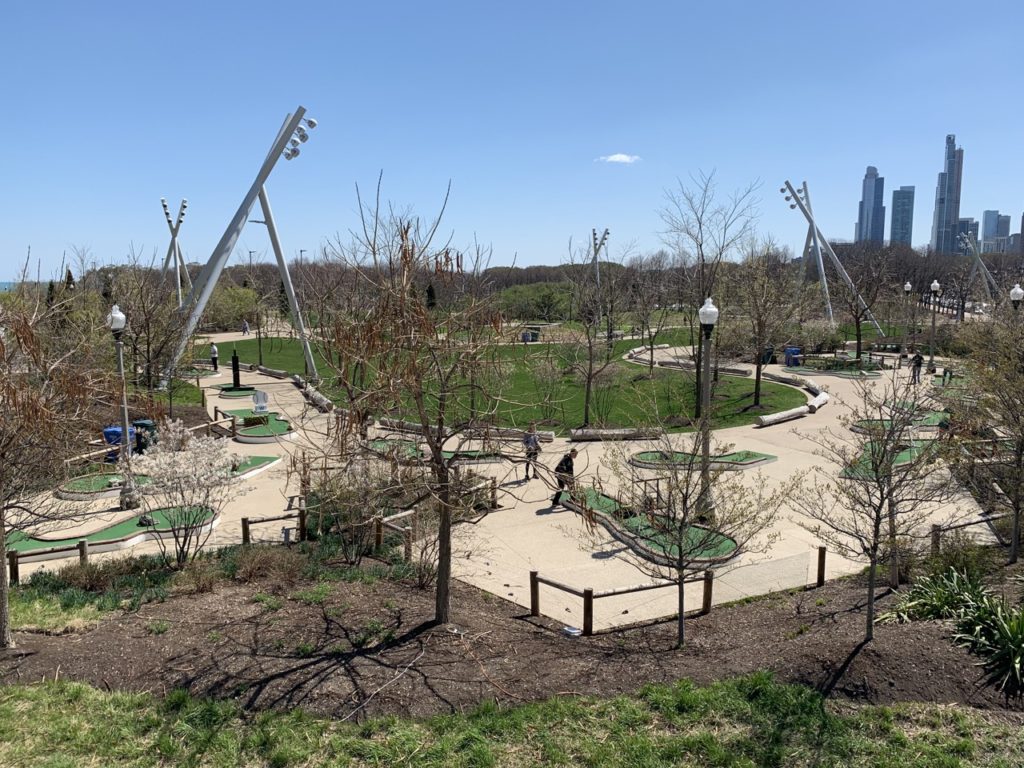
Between being new, off the main tourist route, open, and less popular than Millennium Park, Maggie Daley Park remains something of a peaceful refuge in Chicago.
That’s not to say it’s empty–the children’s Play Garden in particular is busy most of its open hours–but it has nowhere near the tourist density of Millennium Park.
Maggie Daley Park vs. Millennium Park
Nothing in this section is “need to know,” but we think there’s so much of Chicago culture reflected in these two parks that we couldn’t pass up the chance to ramble about it. If you’re not interested, simply jump down to the next section–Maggie Daley Park Hours and When to Visit.
Maggie Daley Park and Millennium Park, though being sisters of a sort, stand in stark contrast to one another. Millennium Park is a celebration of the arts, while Maggie Daley Park is more on the fun and whimsical side of things.
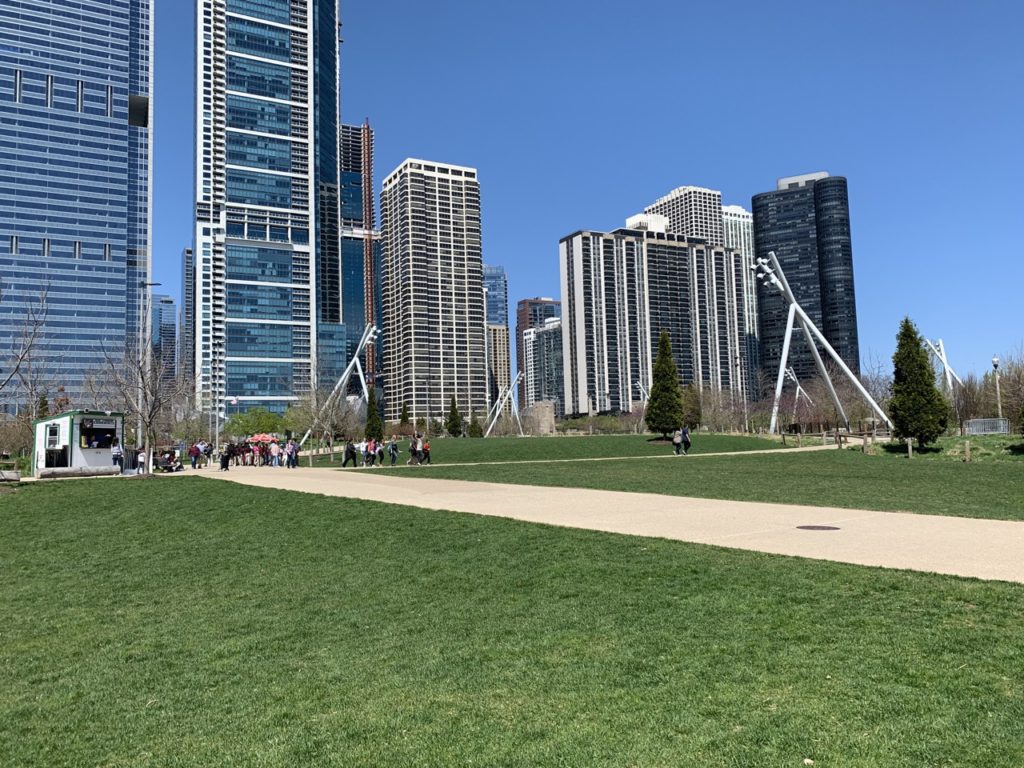
Millennium Park is densely packed with one, large event-space lawn. Maggie Daley Park is a more traditional park space–lots of green with activities spread throughout.
I can’t say whether this duality is intentional, but it’s very Chicago. The City in a Garden has an obsession with the waterfront and particularly with the space currently occupied by Maggie Daley Park, Millennium Park, and Grant Park.
So strong is the movement to keep Chicago’s green space in tact that the threat of litigation has scared off two major projects from the area in recent years. The Chicago Children’s Museum, now at Navy Pier, was originally intended for the space occupied by Maggie Daley Park
More recently, though problematic on different legal grounds, George Lucas’s museum project, planned for a waterfront area farther south was eventually abandoned because of ongoing litigation.

Returning from that digression, if Chicago is the City in a Garden, then Millennium Park–the park on the side of the city–could be seen as the “City” side of the park complex and Maggie Daley Park–the park on the side of the waterfront–as the “Garden.”
With its focus on the arts, Millennium Park truly encapsulates much of the city around it. As we’ve written elsewhere, Cloud Gate (“The Bean”) even visually brings the city into the park.
By contrast, Maggie Daley Park is more a celebration of nature. Even its artificial aspects celebrate nature–there’s the climbing wall, with its bumpy natural form, along with play areas with names like “The Wave,” “The Enchanted Forest,” and “The Sea.”
Even the structure of the two parks plays into this contrast. Millennium Park is highly organized and roughly on a grid–not unlike the city of Chicago itself. The paths of Maggie Daley Park are more natural and winding.
Maggie Daley Park Hours and When To Visit
Maggie Daley Park is open 6AM to 11PM every day of the year. Certain attractions within the park have more limited hours (we cover those throughout).
Unlike Millennium Park, there really is a best time to visit Maggie Daley Park–summer.
During the summer, the park sports both an outdoor climbing facility and a miniature golf course. The vast amount of green space is perfect for relaxing. You can easily pair your visit with a stroll along the lakefront.

Winter is more touchy. The rolling shape of the park means path closures due to dangerous ice occasionally occur. The BP Pedestrian Bridge connecting the park to Millennium Park also often closes in winter.
The real highlight of a winter visit is the ice skating ribbon. Unfortunately, with the more famous and picturesquely downtown McCormick Tribune Ice Rink next door in Millennium Park, the ice skating ribbon usually isn’t reason enough to make the visit to Maggie Daley Park in the winter.
Maggie Daley Park Location
Maggie Daley Park occupies the northeast corner of Chicago’s Grant Park, in the Loop neighborhood of Chicago. Its address is 337 E Randolph St, Chicago, IL 60601. To see Maggie Daley Park in Google Maps, click here.
Maggie Daley Park is bound by Randolph Street (to the north), Columbus Drive (west), Monroe Street (south), and Lake Shore Drive (east). Most notably, Maggie Daley Park is just to the east of Millennium Park, and the two are connected by the BP Pedestrian Bridge.
How to Get to Maggie Daley Park
(Note: You may notice a lot of similarity between this section and the corresponding section in our Millennium Park post because they are so close to each other.)
Our Maggie Daley Park tour starts with the BP Pedestrian Bridge connecting Millennium Park to Maggie Daley Park. This is also where our Millennium Park tour ends. For this reason, we generally recommend starting your visit with Millennium Park.

From much of downtown Chicago, the easiest way to get to Maggie Daley Park will be to walk. If you’re a little farther, or if you don’t care for walking, the bus may be a good option. We recommend using Google Maps for directions.
Coming from the north, for more scenic routes than what Google might automatically suggest, consider walking along Michigan Avenue (the Magnificent Mile) or the Chicago River.
From the DuSable Bridge (where Michigan crosses the river), walk 7 minutes south to Millennium Park, which we suggest visiting before Maggie Daley Park (our itinerary for Millennium Park ends heading into Maggie Daley Park).
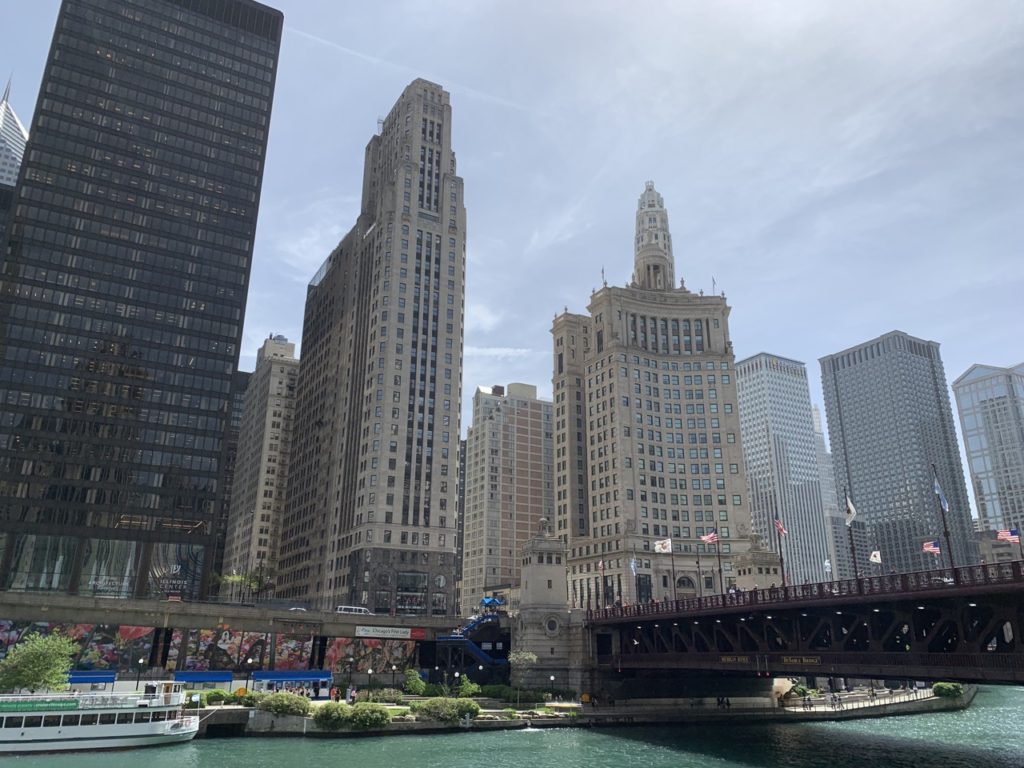
Alternatively, follow the Lakefront Trail (along the Lake) to the Randolph Street crosswalk. Crossing under Lake Shore Drive will put you right into the park, or you can walk straight west on Randolph if you’re starting with Millennium Park.
From the south, your best bet at extra scenery will be along the Lakefront Trail, with highlights being Museum Campus and Buckingham Fountain. You can use the Monroe Street crosswalk and either start in that corner of Maggie Daley Park or head west to Millennium Park.
Parking at Maggie Daley Park
If you’re driving, there are plenty of garages at and near Maggie Daley Park. The garages under the park itself will probably cost between $20 and $40 for your visit.
There’s no one perfect way to drive to Maggie Daley Park, as it is centrally located downtown. Use Google Maps and follow its directions, being careful to keep in mind there are several multi-level streets in the area (if you get lost underground, just follow and signs back to the surface and then reset your GPS).
Taking the L Train System to Maggie Daley Park
Taking the L to Maggie Daley Park is incredibly convenient and easy. From the Red Line, get off at the Lake Street (State and Lake) stop. Via the Yellow Line and Purple Line (non-rush period), transfer to the Red Line at Howard. From the Blue Line, use the Washington stop.
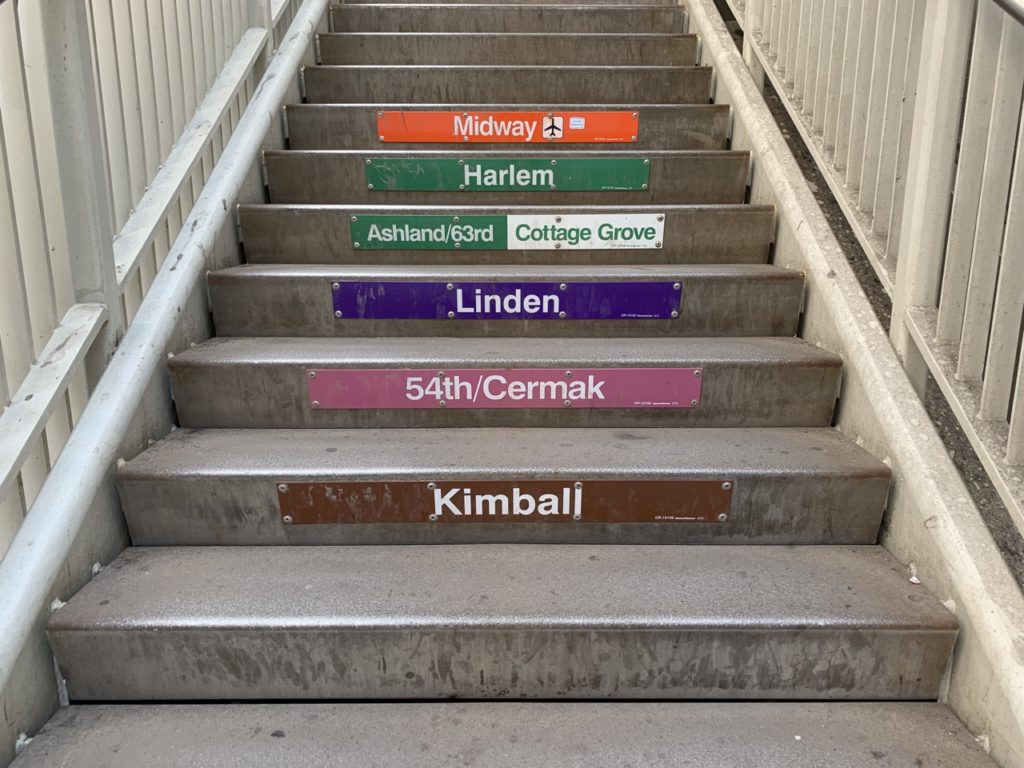
Via the Green, Brown, Purple (rush periods only), Orange, Pink Lines, use the Washington and Wabash stop.
All of these stops are west of the park, in the Loop. Head east (toward the lake) to get to Millennium Park and then farther east to Maggie Daley Park.
We have a Guide to taking the Chicago “L” Train System.
Taking the Metra to Maggie Daley Park
If the Metra is more convenient, you’ll have a few options. The Metra Electric District Line, which services the southern portion of the city and some south suburbs, has its northernmost stop at the Millennium Station stop, right at Millennium Park.
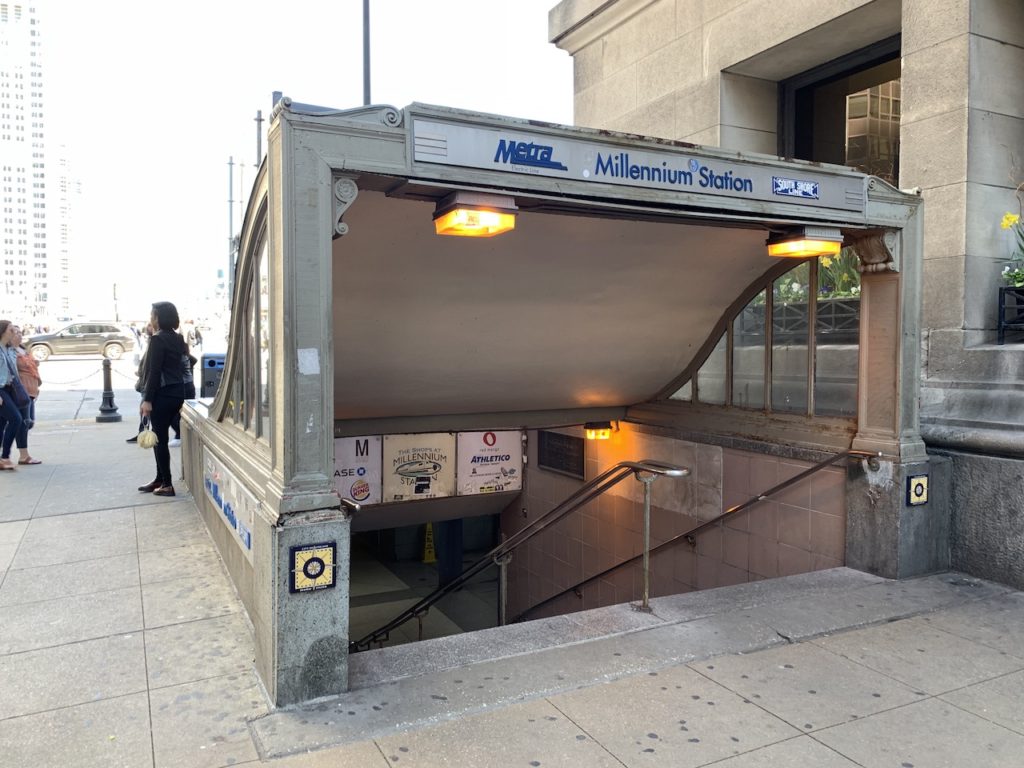
Other Metra Lines don’t put you as close to Maggie Daley Park. There are three other Metra terminals downtown–Union Station, Ogilvie Station (OTC), and LaSalle Street Station. Each of these is about a 25-minute walk from Maggie Daley Park (use Google Maps). These walks are all simple, scenic (in an urban sense), and safe, and we recommend them for anyone who is new to the Loop.
From OTC and Union Station, you could alternatively follow the river north and east for a longer, more scenic route, you’ll just put yourself about 7 minutes north of Millennium Park when you get to Michigan Avenue.

If you’d prefer to skip the walk from Union Station you can walk across the river to the Quincy L Station and take the Brown or Orange Lines (not Pink or Purple) to Washington and Wabash.
From Ogilvie (OTC), use the nearby Clinton station and take the Green Line or Pink Line (Loop direction) to Washington and Wabash. From LaSalle Street, use the connected LaSalle Street Blue Line Station to take the Blue Line (O’Hare Direction) to Washington.
Taking the South Shore Line to Maggie Daley Park
Finally, the South Shore Line–a train line that operates from South Bend Indiana along the lake and into Chicago, also has an endpoint at Millennium Station.
Maggie Daley Park Geography and Map
Unlike Millennium Park, Maggie Daley Park doesn’t break down into neat rectangular sections. Nonetheless, we’re happy to give an overview of its layout.

The BP Bridge is the winding, metallic bridge that connects Maggie Daley Park to Millennium Park across Columbus Drive. North of the bridge, in the northwest area of the park (blue above) are the climbing wall, skating ribbon, and field house.
The northeast corner of the park is the Cancer Survivor’s Garden (yellow rectangle). There are also a few tennis courts filling out the space between the Garden and Lake Shore Drive.
The southeast portion of the park is the Play Garden (red above), a collection of six themed playgrounds for children.
The remainder of the park is mostly green space. There is also a small cafe near the climbing wall, and a mini-golf course in the middle of the park.
Tour of Maggie Daley Park
This tour starts from the end of the BP Pedestrian Bridge that connects Maggie Daley Park with Millennium Park (we recommend starting this entire tour with Millennium Park) and ends in the Play Garden in the south end of the park.
Map and Itinerary for Maggie Daley Park Tour
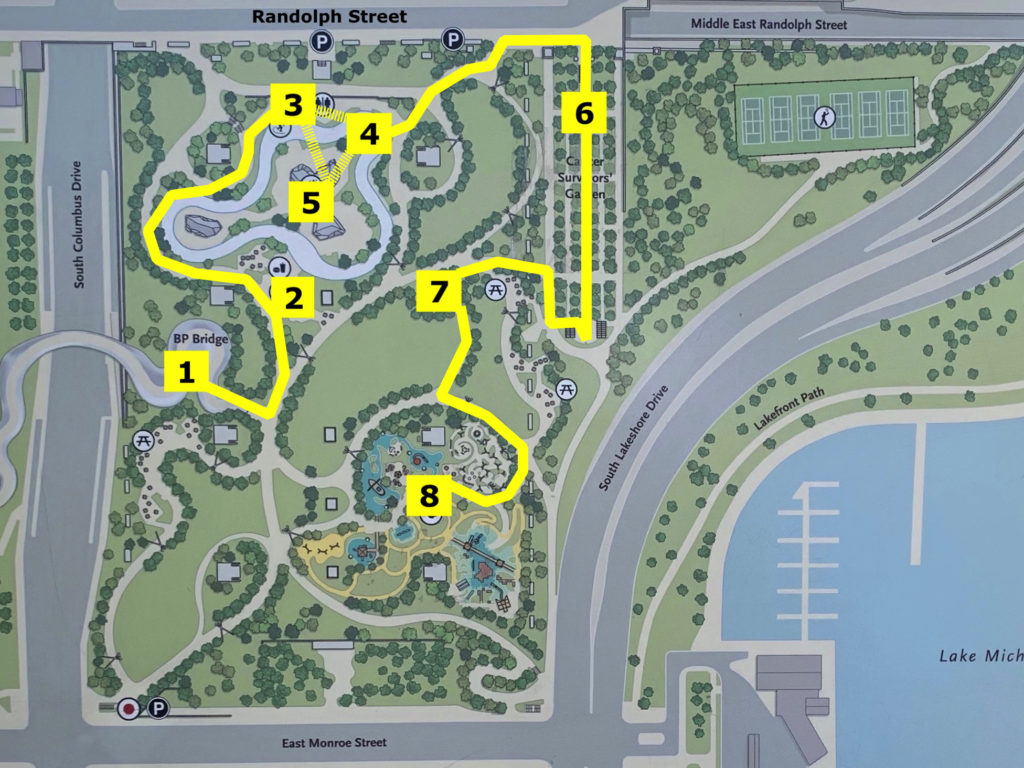
- BP Pedestrian Bridge
- Rink Cafe
- Field House
- Skating Ribbon
- Climbing Wall
- Cancer Survivor’s Garden
- City Mini Golf
- Play Garden
BP Pedestrian Bridge [1]
The BP Pedestrian Bridge was built with Millennium Park, and so it predates Maggie Daley Park by about a decade.
In case you haven’t read our Millennium Park tour, we want to point out one fun fact easily viewed from the Maggie Daley Park side of the bridge.
Walk a bit up the bridge and look across Columbus Drive. You’ll see the other end of the bridge with Jay Pritzker Pavilion in the background.

The design of the bridge is such that it acts as a sound barrier, protecting the pavilion from the noise of traffic on Columbus Drive. It’s surprising effective, so much so that the pavilion is actually noted for its high sound quality.
Walking off the BP Pedestrian Bridge, Maggie Daley Park welcomes you with open arms.
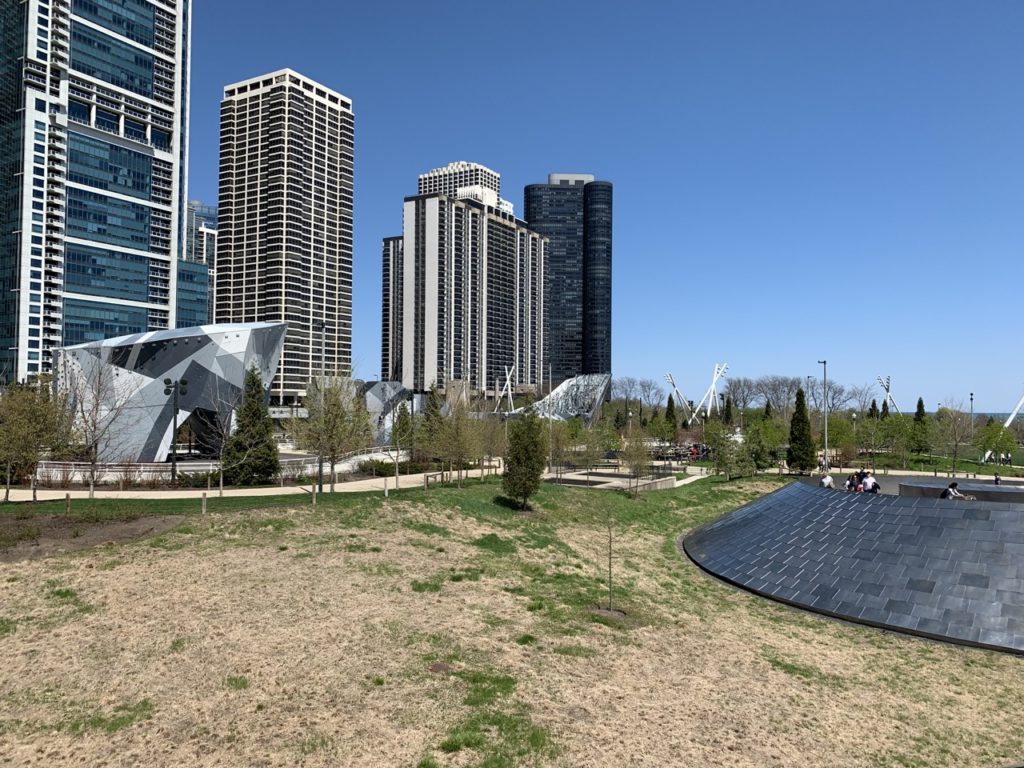
There’s really no “right” way to walk around the park, and any route you take is probably going to involve a few loops out of your way.
We’re going to start by turning left (north) to head to the field house, skating ribbon, and climbing wall.
Rink Cafe [2]
On the way you’ll pass Rink Cafe, a small cafe at Maggie Daley Park. They serve simple items–hot dogs ($5.25), burgers, nachos ($4.50), ice cream, and so on. There are a few picnic tables there and more throughout the park.

The Field House is a mostly unmarked structure north of the climbing walls and ribbon. One pathway actually goes over the top of it, which can make it a bit tricky to get to. It looks like this:

Maggie Daley Park Field House [3]
There’s an information desk just to the right when you enter the Field House. The desk at the rear is where you can rent equipment and sign up for climbing. Here’s the 2019 price list:
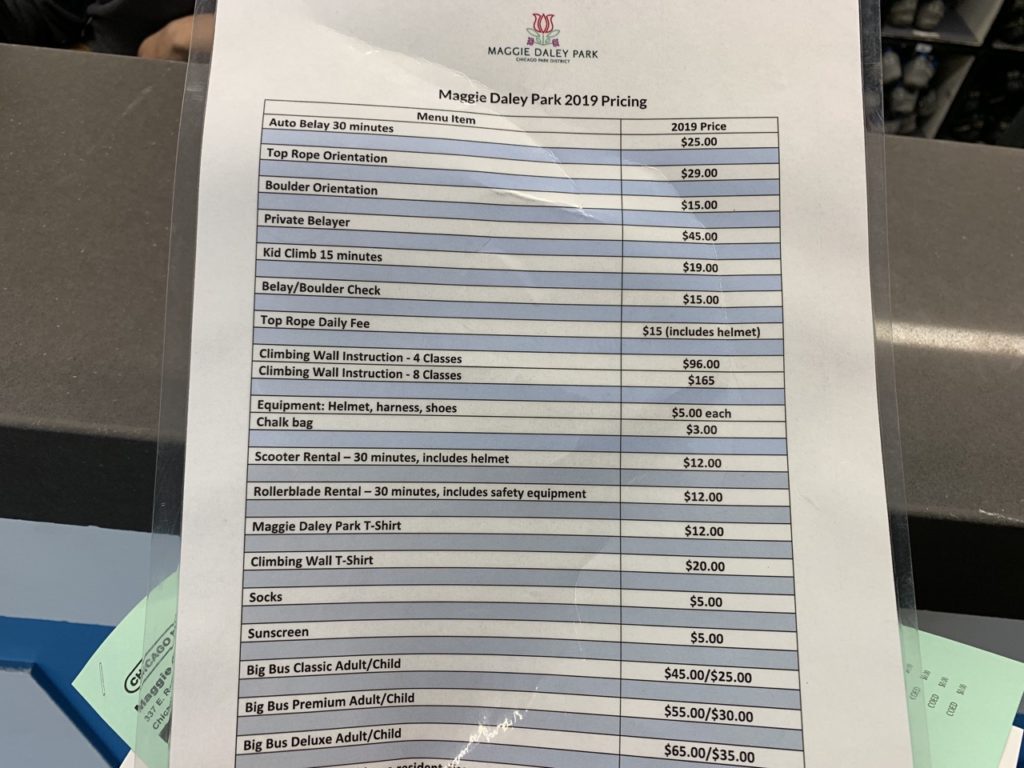
They also sell a variety of branded gear, as well as sunscreen and tennis balls.

There are lockers available for rent for $2.
If you don’t use a locker and you leave your items unattended, your stuff will likely wind up on an unattended item rack (there are a few throughout the park).
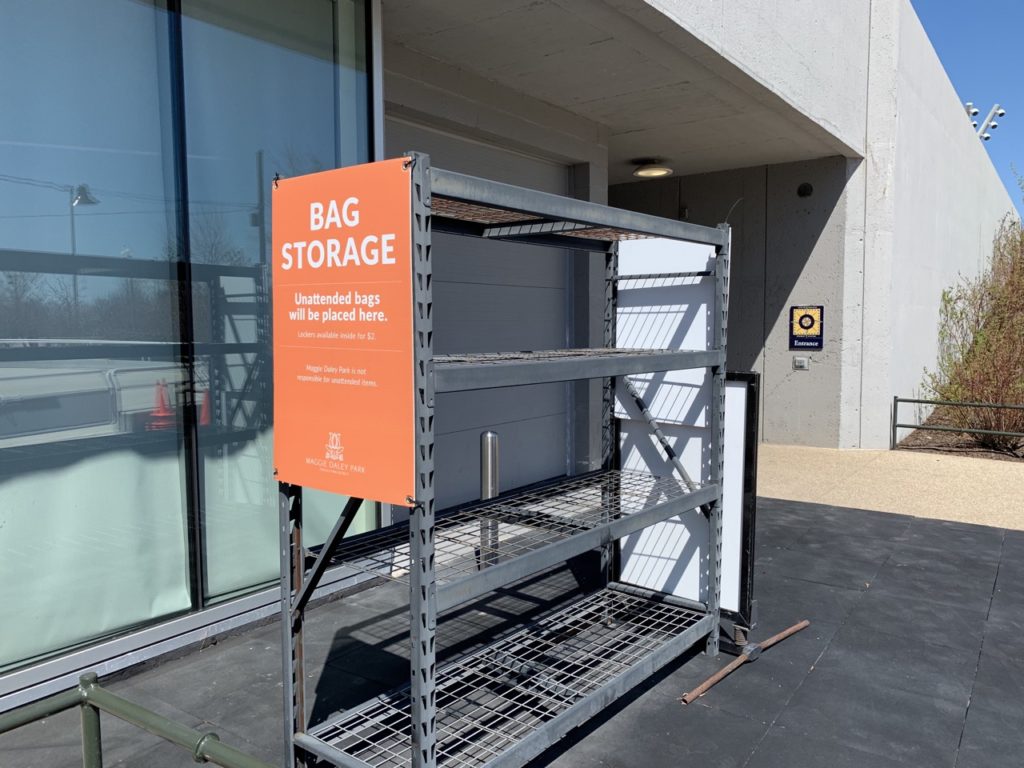
Maggie Daley Skating Ribbon [4]
Just outside the field house, the skating ribbon is a closed loop around the climbing walls. It’s just less than 1/4 of a mile long.
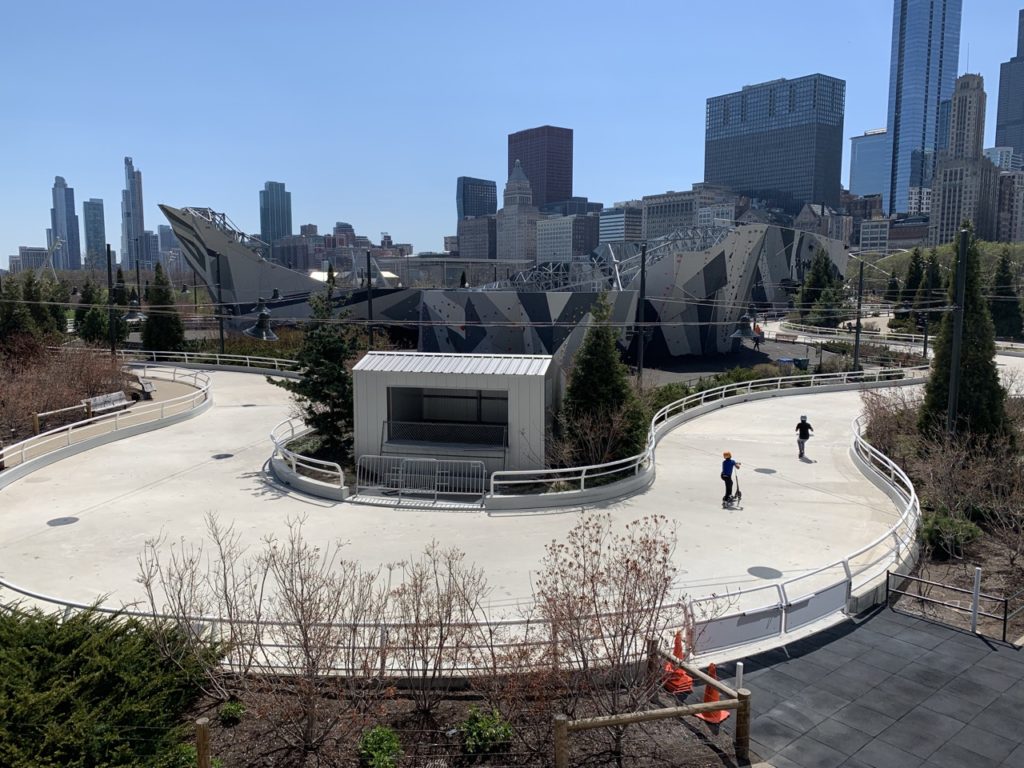
Traffic around the skating ribbon flows counterclockwise. You can rent roller blades or a scooter for 30 minutes for $12 in the Field House. You’re also free to walk around the ribbon.
During the winter, the ribbon is an ice skating ribbon. Skate rental is available for $12 or $14, depending on the day. Access to the ribbon is free.
Climbing Walls at Maggie Daley Park [5]
The two climbing structures are in the middle of the skating ribbon. The above price list indicates the pricing for different services / equipment, and more information can be found on the Maggie Daley site here.
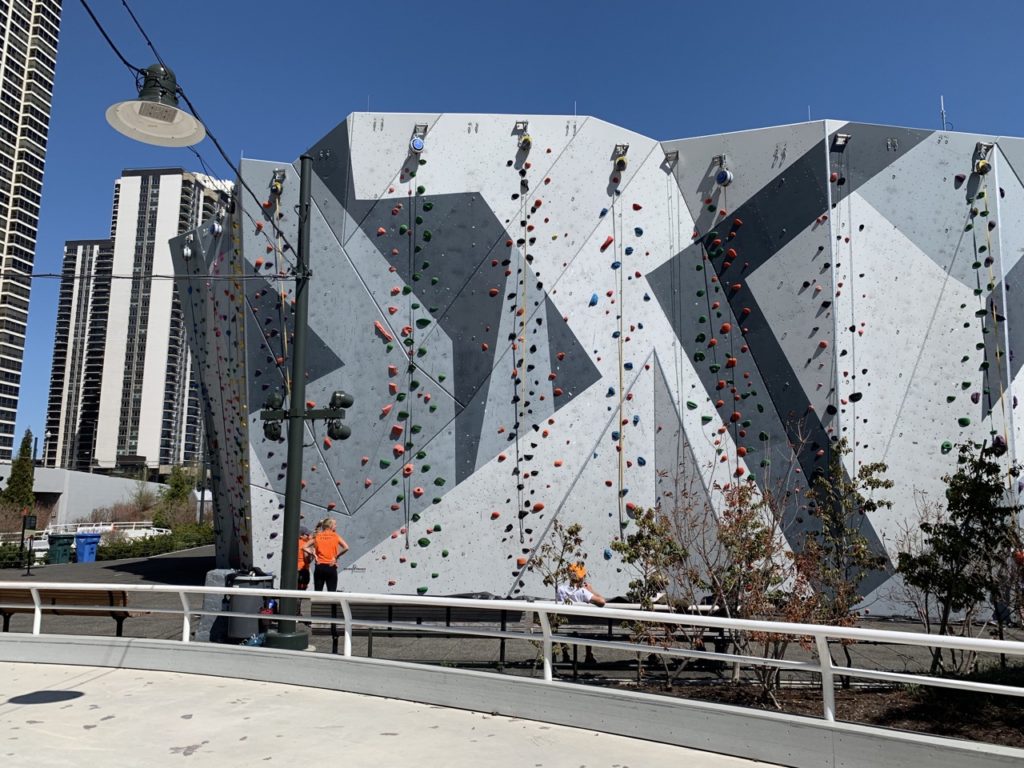
Some quick notes:
- the climbing walls are all outside, so inclement weather may result in their closure
- all first-time climbers must complete a certification course (15 minutes or 45 to 60 minutes depending on the type of climbing)
- climbing time is unlimited unless the walls become too busy (auto belays are charged by 30 minutes or the hour)
- it’s recommended that all climbers bring a friend (auto belay is also available, or instructors may be available for hire)
Cancer Survivors’ Garden [6]
East of the ribbon and climbing wall is the Cancer Survivors’ Garden. The best way to visit is to exit the park briefly onto Randolph Street (the north end) and start at the north end of the garden.
The north end is flanked by two columns from the old Chicago Federal Building. Looking south from the north end of the garden, you’ll see the Field Museum at the far end of Lake Shore Drive.

According to the Maggie Daley Park website, the “three main garden rooms represent the three main states of healing: acceptance, support and celebration.”
The garden is actually one of 24 such parks around the United States. The Bloch Family Foundation website states of the parks:
To newly diagnosed patients, it is meant to give hope and courage. To those in the process of fighting the disease, it is meant to give directions and determination. To those who have not had cancer, it is meant to reduce fear.
Bloch Family Foundation Website
While the message is no doubt one of positivity, you might think the garden is an odd choice for the otherwise whimsical Maggie Daley Park. There are two things to note here.
First, the garden is older than the park, having opened in 1996, nineteen years before Maggie Daley Park debuted. Being absorbed by the park was actually crucial for the continued funding for the maintenance of the garden.
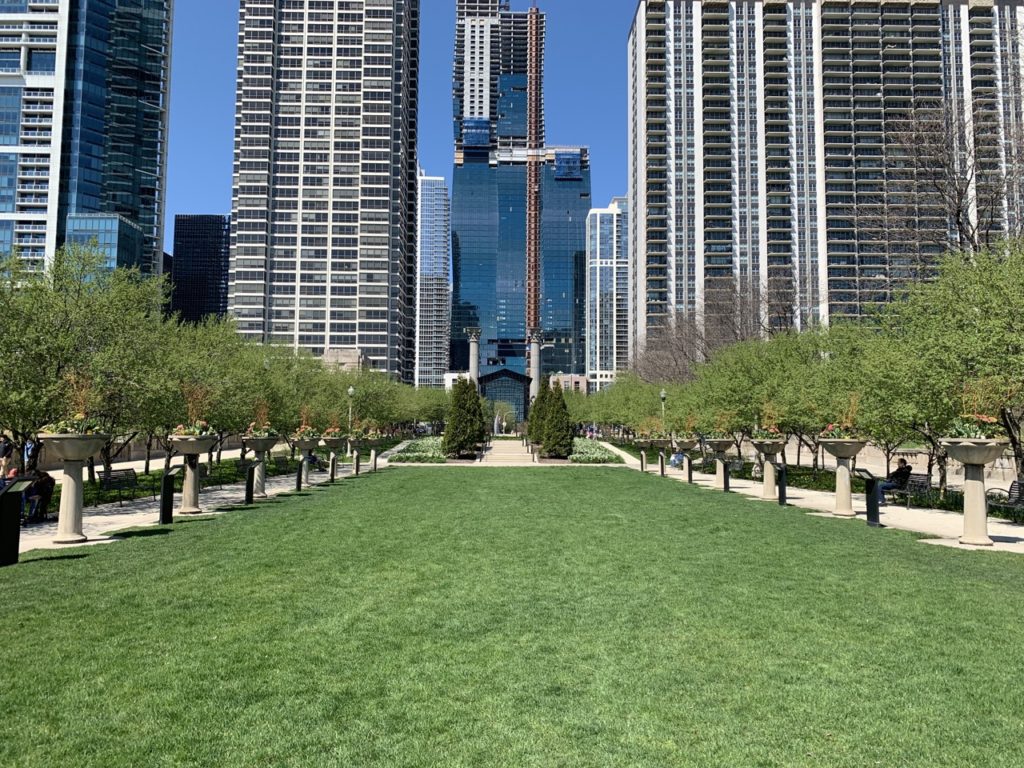
Second, Maggie Daley herself died in 2011 following a battle with metastatic breast cancer. The park named after her was announced less than a year later.
Exiting the garden through the south, the only remaining major feature is the Play Garden. Before we get there, though, you might want to turn right and backtrack slightly, toward the skating ribbon. In the middle of the park, you’ll encounter City Mini Golf.
City Mini Golf at Maggie Daley Park [7]
City Mini Golf is an 18-hold miniature golf (“putt putt”) course in Maggie Daley Park. Having never played it myself, I can’t say too much about it. The course uses Chicago landmarks–like Willis Tower and the Chicago Theatre sign–as obstacles.

It is typically open from mid April through mid October from 10AM to 9PM (last group starts at 8:45PM). General admission is $11.
Heading back to the southeast corner of the park, we come to one of the busiest areas–the Play Garden.
Play Garden [8]
The Play Garden consists of six playground structures targeting children of different ages. They are: The Watering Hole (Ages 2-5), The Harbor (Ages 2-5), The Sea (Ages 5-12), Slide Crater (Ages 5-12), Enchanted Forest (All Ages)
Wave Lawn (All Ages).
The Play Garden is probably one of the best play areas for kids in the entire city. Unfortunately, you’ll have to take our word for it at the moment because we don’t have photos because, well, it’s not cool to take lots of photos of strange children and publish them on the internet.
That wraps up the tour of Maggie Daley Park! Hope you had a fantastic visit!
